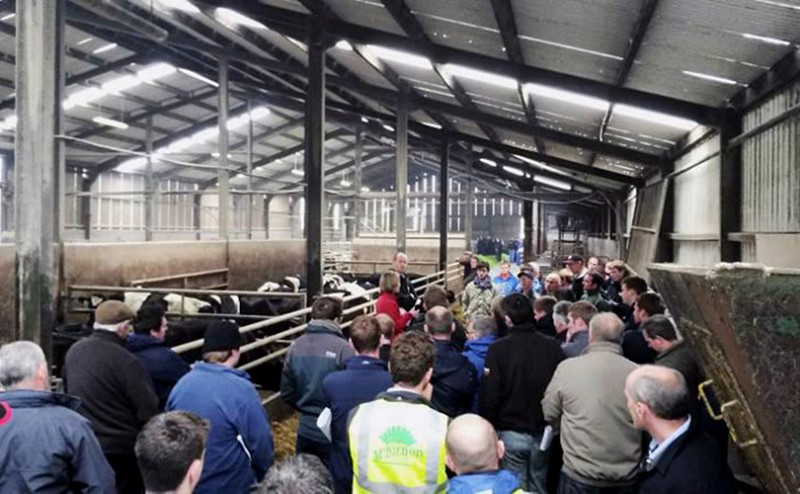
Approximately 400 farmers from across Northern Ireland turned out for this year’s Annual National Milk Records (NMR) Open Day which was hosted by the Fullerton family of Lisnamuck Holsteins. Sean Fullerton recalls an eventful day in conversation with Irish Tractor magazine.
One of the highlights of the dairying year in Northern Ireland, the NMR Open Day is designed to give those in attendance a unique insight into the management practices that have been put in place to deliver the growth in the business that has been achieved over the past number of years.
The theme for the day was “driving dairy efficiency – from birth to bulk tank” and presentations were given by the host Sean Fullerton, David Mawhinney, McLarnon Feeds; Mairead O’Grady, MSD; Liam Young, Drumrainey Vets; Lucy Andrews, NMR and Dr Ronald Annett, McLarnon Feeds.
The talks ranged from subjects such as ‘herd performance, management and feeding’ to ‘getting calves on target for a lifetime of productivity’ to ‘efficiency through genomic testing’ to ‘zero grazing – the merits and the costs’.
“It was a great success,” commented Sean Fullerton, “there were no bad comments anyway! It went the way it was planned so everyone seemed to be happy and there was a a big turnout with over 400 people attending.”
How did the Fullerton family get picked to host the day? “I was caught unawares a bit,” he recalled. “Ivor Hyndman of NMR asked me would I be interested in hosting the day. I said I’d think about it but the next thing I knew it was a done deal – but it worked out well.”
Sean might be doing himself something of a disservice with that modest answer because the Fullerton’s farm was the perfect fit to be associated with such a prestigious event.
Their herd has expanded from 140 to 240 cows over the past five years, with high-yielding cows milked through a robot and the end product sold to Green Pastures in Donegal.
Very much the definition of a family effort, Sean is joined in the day-to-day running of the business by his father Patrick, son Kevin and wife Margaret and all have a say in the decision making process.
“The Fullertons have been here for generations,” Sean outlined. “My father left school over 50 years ago and started milking. I left school in 1988, we had 30 cows then and today we have 240. We gradually increased the number over the years but particularly in the last five years when we added an extra 100.
“My son Kevin, who attended Greenmount College, has been working full-time with us since 2011 while my wife Margaret, who left her job a year ago, looks after the accounts and the robot. There are also two uncles and two cousins who help out at silage time.
“It’s a family affair, we don’t employ anyone outside of the family and my father is still very active on a daily basis.”
The Lisnamuck herd of full pedigree Holstein Friesians is currently averaging 9,476 litres with excellent butterfat and protein levels with 3,500 litres produced from forage. Cell counts are below 100,000 cells per/ml.
The introduction of zero grazing system has reaped huge dividends for the Fullerton’s.
“The zero grazing approach has worked well for us,” Sean added. “Putting the cows out to grass is not a feasible option on the farm: so we bring the fresh grass to the cows.
“We plan to introduce the fresh grass into their diets as early in the spring as possible and we will continue on with this approach well into the autumn.
“Achieving the highest possible standards of grassland management is a key objective for the business. We re-seed up to 50 acres each year.”
The recent installation of SAC Futureline Max robots on the farm has proven to be money well spent in helping to save time and, most importantly, ensure that all fresh cows are milked consistently well at all times.
Excellent cow fertility is another cornerstone of the Fullerton’s approach while no stone is left unturned in the calf rearing practices in operation on the farm. Every aspect of the young animals’ nutritional, health and welfare needs are addressed. As a result, heifers are brought through to calving at around 24 months with little or no difficulty.
The only dark cloud on the horizon is the current milk price but as Sean pragmatically puts it: “That is the biggest challenge but that’s the challenge for everybody in the dairy industry at the minute.”
Sean Fullerton
Lisnamuck Holsteins
42 Lisnamuck Road
Maghera
Co Derry
Taken from Irish Tractor & Agri magazine Vol 4 No 1, January 2016